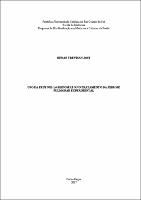| Share record |


|
Please use this identifier to cite or link to this item:
https://tede2.pucrs.br/tede2/handle/tede/7483| Document type: | Dissertação |
| Title: | Uso da frutose-1,6-bisfosfato no tratamento da fibrose pulmonar experimental |
| Author: | Jost, Renan Trevisan  |
| Advisor: | Oliveira, Jarbas Rodrigues de |
| First advisor-co: | Melo, Denizar Alberto da Silva |
| Abstract (native): | A fibrose pulmonar é uma forma específica de pneumonia intersticial caracterizada por piora progressiva da dispneia e da função pulmonar e associada a um mau prognóstico. Além da causa idiopática, a fibrose pulmonar pode ser causada por drogas como a bleomicina (BLM) - usada no tratamento de linfomas e tumores germinativos. A frutose-1,6-bisfosfato (FBP) é um composto glicolítico endógeno de alta energia que possui efeitos antifibróticos, anti-inflamatórios e imunomodulador. O objetivo deste estudo foi avaliar o efeito da FBP sobre um modelo de fibrose pulmonar induzida por BLM em camundongos e investigar seu efeito utilizando um sistema de cultura de fibroblastos de pulmão embrionário humano (MRC-5). Camundongos C57BL/6 foram divididos em grupos Controle, FBP, BLM, BLM + FBP. Foi administrada uma dose única de bleomicina intratraqueal (7,5 U/kg) para avaliar a sobrevivência, o acompanhamento do peso corporal, o escore Ashcroft e a histologia (hematoxilina-eosina, tricrómio de Masson e picrosirius). Para avaliar a função pulmonar e o lavado broncoalveolar (LBA) foi administrada uma dose única de bleomicina a 1,2 U/kg por via intratraqueal. O tratamento com FBP (500 mg/kg) foi administrado no dia 0 intraperitonealmente. Fibroblastos (células MRC-5) foram utilizados para acessar o efeito da FBP in vitro. In vivo, a FBP aumentou a taxa de sobrevivência e reduziu a perda de peso corporal quando BLM e BLM mais FBP foram comparados (p <0,05). FBP também previne a perda de função pulmonar causada por BLM e diminuiu as células inflamatórias no LBA. O grau de fibrose e a densidade superficial de colágeno foi menor nos pulmões de animais que receberam BLM mais FBP comparado com BLM apenas (p <0,05). In vitro, a FBP (0,62 e 1,25 mM) apresentou actividade inibidora em células MRC-5 e foi capaz de induzir a senescência em fibroblastos. Estes resultados mostraram que a FBP tem o potencial de reduzir os efeitos tóxicos da bleomicina e pode proporcionar terapia de suporte para métodos convencionais de pacientes que utilizam essa terapia para o tratamento do câncer. |
| Abstract (english): | Pulmonary fibrosis is a specific form of interstitial pneumonia characterized by progressive worsening of dyspnea and lung function and associated with a poor prognosis. In addition to the idiopathic cause, pulmonary fibrosis may be caused by drugs such as bleomycin (BLM) - used in lymphomas and germinative tumors treatments. Fructose-1,6-bisphosphate (FBP) is a high energy endogenous glycolytic compound that has antifibrotic, anti-inflammatory and immunomodulatory effects. The aim of this study was to assess the effect of FBP on BLM-induced pulmonary fibrosis model in mice and investigate its effect using a human embryonic lung fibroblast (MRC-5) culture system. C57BL/6 were divided into Control, FBP, BLM and BLM plus FBP. A single dose of bleomycin (7.5 U/kg) was administered intratracheally in mice and survival, body weight, Ashcroft Score and histological analysis (hematoxylin-eosin, Masson’s trichrome and picrosirius) were performed. Pulmonary function and bronchoalveolar lavage fluid (BALF) were also evaluated after a single dose of bleomycin (1.2 U/kg – intratracheally). Treatment with FBP (500 mg/kg) was given on day 0 intraperitoneally. Fibroblasts (MRC-5 cells) were used to access the effect of FBP in vitro. In vivo, FBP increased survival rate and reduced the body weight loss when BLM and BLM plus FBP were compared (p< 0.05). FBP also prevented the loss of pulmonary function caused by BLM and decreased BALF inflammatory cells. The level of fibrosis and the superficial collagen density were lower in the lungs of animals that received BLM plus FBP as compared to BLM only (p<0.05). In vitro, FBP (0.62 and 1.25 mM) had inhibitory activity on MRC-5 cells and was able to induce senescence in fibroblasts. These results showed that FBP has the potential of reducing the toxic effects of BLM and may provide supportive therapy for conventional methods used for the treatment of cancer. |
| Keywords: | Fibrose Pulmonar Bleomicina Análise de Sobrevivência Fibroblastos |
| CNPQ Knowledge Areas: | CIENCIAS DA SAUDE::MEDICINA |
| Language: | por |
| Country: | Brasil |
| Publisher: | Pontifícia Universidade Católica do Rio Grande do Sul |
| Institution Acronym: | PUCRS |
| Department: | Escola de Medicina |
| Program: | Programa de Pós-Graduação em Medicina e Ciências da Saúde |
| Access type: | Acesso Aberto |
| Fulltext access restriction: | Trabalho não apresenta restrição para publicação |
| URI: | http://tede2.pucrs.br/tede2/handle/tede/7483 |
| Issue Date: | 10-Mar-2017 |
| Appears in Collections: | Programa de Pós-Graduação em Medicina e Ciências da Saúde |
Files in This Item:
| File | Description | Size | Format | |
|---|---|---|---|---|
| DIS_RENAN_TREVISAN_JOST_PARCIAL.pdf | Texto Parcial | 919.29 kB | Adobe PDF |  Download/Open Preview |
Items in DSpace are protected by copyright, with all rights reserved, unless otherwise indicated.




